The Wood Bison Discovery Story
Posted by: Loren Coleman on July 11th, 2008
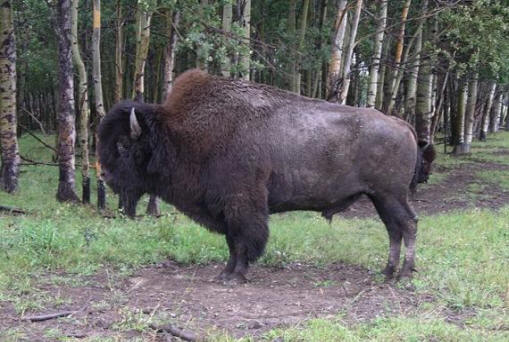
Could a bunch of large, hairy, near-human ape-men, or hirsute giants, be living unfound in America? A parallel story from just fifty years ago, suggests that this is a very real possibility.
The largest land animal in Canada, the wood bison [shown above], had been disappearing from all over North America for centuries when the last animals were officially declared extinct in 1940. Then in 1957, a wonderful discovery occurred. During a regular air patrol, federal wildlife officers flying over a remote part of the Wood Buffalo National Park, Alberta, spotted a small, isolated herd of two hundred wood bison. They had gone completely unnoticed for decades – and had kept physically and genetically separate from their cousins, the plains bison, so familiar to Americans as the buffalo. The wood bison were found about one hundred miles from a new road being built from Alberta to the arctic circle and within fifty miles of a mission station that had existed for a hundred years. Inspection of these animals showed that they were indeed the last remaining pure wood bison (Bison athabascae), an enormous Ice Age species not known to exist in a pure strain anywhere else in the world.
The rediscovery of a hidden group of wood bison in a remote valley in Canada is as remarkable as the discovery of the coelacanth, the mountain gorilla, and the giant panda. I don’t believe those that insist that North America has no new secrets.
~ Taken from pages 7 & 8 of Bigfoot! The True Story of Apes in America (NY: Simon and Schuster, 2003).
Since I am traveling to Alberta soon, I wanted to dust off this story to make certain I discuss it at the Royal Alberta Museum (during my forthcoming talk on Sunday, July 20th). Perhaps there are even some wood bison nearby that I may observe – at the zoo – since I realize how significant they are?
This animal tale is one the late Ivan T. Sanderson and I have both used to demonstrate the simple fact that large animals can remain hidden in North America, quite near humans, relatively speaking.
Yes, there may be some dispute with my elevating the wood bison to species status, as the debate is ongoing, and the general notion is it is merely a subspecies of the plains bison. But I find that neither here nor there, as the differences between the wood and plains animals are distinctive and the wood bison went undetected, which is the point of the story. There are lessons to be learned from this cautionary tale of thinking all is known out there in the woods.
The wood bison is visibly different from the plains bison in a number of important ways, some of which may be viewed in the graphic below. Most notably, the wood bison is heavier, with large males weighing over 900 kilograms (approximately 2000 lbs), making it the largest terrestrial animal in North America.
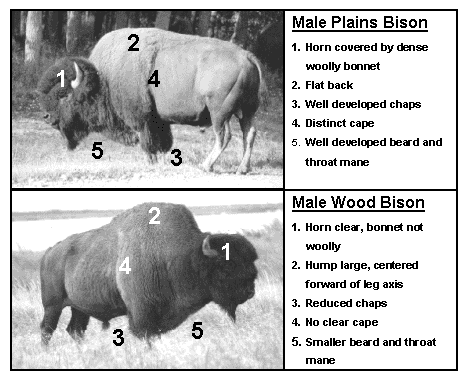
BTW, the notion that the wood bison is an “ecotype” of the plains bison, in which the plains animals can naturally change configurations and appearance if brought into an ecosystem similar to the wood bison’s, is a false argument. It has been disproven by the natural experiment of the relocation of a group of plains bison to Alaska in the 1940s. Despite breeding and living in a wood bison environment for decades now, that specific group of plains bison have remained plains bison, in appearance, behavior, and every other respect.
Wood bison are now being reintroduced to Alaska, as Chad Arment mentioned over at Strange Ark a few months ago.
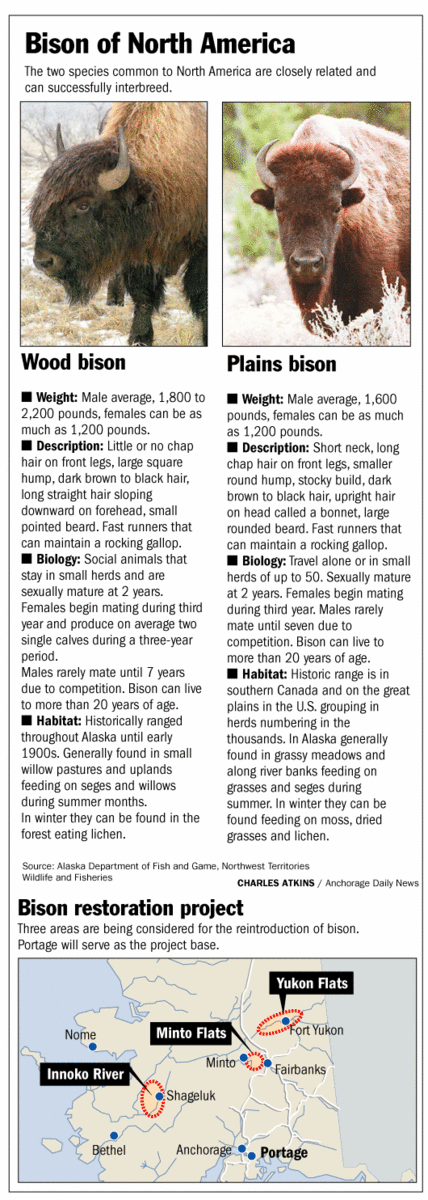
Source: The Anchorage Daily News
I also am intrigued by the cave drawings that seemingly represent the wisent or European bison (Bison bonasus) – said to have three subspecies – which are today regarded as a separate species from the plains (Bison bison bison) bison and the wood bison (Bison athabascae or Bison bison athabascae).
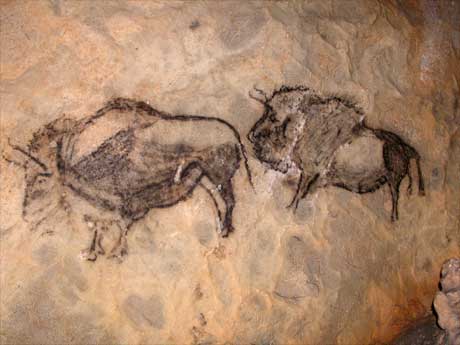
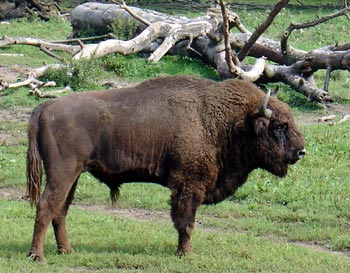
Wisent.
The “ordinary” bison species are far from mundane, but they do melt into the background, if we don’t pay attention to their importance.
I’ll stay on the lookout for wood bison, alive or mounted in the museum, while I am in Alberta.
On the other hand, I figure if I see a Sasquatch, that will be hard to miss.
^^^^^^^^^^^^^^^^^^^^^^^^^^^^^^^^^^^^^^^^^^^^^^^^^^^^
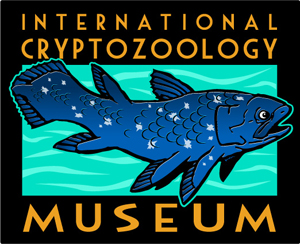
Donations have dropped to nearly zero since July 3rd. Please don’t forget the museum, and remember you may directly send a check, money order, or, if outside the USA, an international postal money order made out to
International Cryptozoology Museum
c/o Loren Coleman
PO Box 360
Portland, ME 04112
Please “Save The Museum”! Easy-to-use donation buttons are now available here or merely by clicking the blank button below. Thanks everyone!
About Loren Coleman
Loren Coleman is one of the world’s leading cryptozoologists, some say “the” leading living cryptozoologist. Certainly, he is acknowledged as the current living American researcher and writer who has most popularized cryptozoology in the late 20th and early 21st centuries.
Starting his fieldwork and investigations in 1960, after traveling and trekking extensively in pursuit of cryptozoological mysteries, Coleman began writing to share his experiences in 1969. An honorary member of Ivan T. Sanderson’s Society for the Investigation of the Unexplained in the 1970s, Coleman has been bestowed with similar honorary memberships of the North Idaho College Cryptozoology Club in 1983, and in subsequent years, that of the British Columbia Scientific Cryptozoology Club, CryptoSafari International, and other international organizations. He was also a Life Member and Benefactor of the International Society of Cryptozoology (now-defunct).
Loren Coleman’s daily blog, as a member of the Cryptomundo Team, served as an ongoing avenue of communication for the ever-growing body of cryptozoo news from 2005 through 2013. He returned as an infrequent contributor beginning Halloween week of 2015.
Coleman is the founder in 2003, and current director of the International Cryptozoology Museum in Portland, Maine.










Very interesting and a point well made! Thanks for sharing that. I hope you get to see one.
I wonder how the European/Asian wisent is doing after the fall of the First Soviet Empire? There were very few left prior to that, and prior to Chernobyl.
Calling them separate species rather than distinct breeds is strange to me, since not only can they interbreed, they interbreed just fine with all other bovines (and make a nice, low-fat hybrid called the ‘beefalo’)
[quote]Yes, there may be some dispute with my elevating the wood bison to species status, as the debate is ongoing, and the general notion is it is merely a subspecies of the plains bison. But I find that neither here nor there, as the differences between the wood and plains animals are distinctive and the wood bison went undetected, which is the point of the story. [/quote]
1. 1940 – 1957 is “undetected” for only 17 years, which is different than “unproven” for 200 years by a wide shot, I would say.
2. I am very skeptical of “undetected”. I would never have come accross these bison and said to my mate, “You know lovie, for a plains bison that beast really should have more chap hair on the front legs!” For this to be an analogous argument, there would have to be another 300lb ape in the Pacific Northwest for us to be assuming is NOT a bigfoot….only to find out later…that some of them are.
Now if this is a stronger arguement than I think it is, then at least there is some great news here. All we have to do is chart the places in the Pacific Northwest that are 100 miles from the nearest road, which would reduce the area we need to search, photo-trap and survey.
sschaper says: “Calling them separate species rather than distinct breeds is strange to me, since not only can they interbreed, they interbreed just fine with all other bovines ”
I think it’s been historically presumed that separate species can’t interbreed. In fact, though, we’ve known they can for a long time (tigons and ligers; mules, from horses and donkeys; and, yes, beefalo). The red wolf nearly drove itself extinct breeding with coyotes. The eastern coyote is said to have an infusion of wolf genes.
I think that species that are closely related CAN interbreed; it’s just that in nature, they tend not to, either because of no range overlap or different social structures. But they can do it.
I easily see the point of a herd of bison being undetected.
Very large mammal roaming about in daylight not trying to hide or be stealthy and is not rediscovered for almost two decades.
It underscores the point if this can be overlooked then what else can be?
Didn’t even know there was a wood bison. Thanks for sharing.
This is sort of anlaogous to the sasquatch, but not exactly, that is, if I understand properly.
Apparently the last herd of wood bison were in an area remote enough that they simply weren’t seen.
Anecdotal reports make it pretty clear that – if they aren’t the result of an unprecedented web of lies or availability of great drugs – LOTS of people are seeing sasquatch, a lot of them right on their property, many looking into their windows.
The difference, sounds to me, shows how blind science can be to something if it wants to be.
DWA- Right. Commonly different closely related species CAN interbreed just fine, and it is usually geographical isolation and differing habitats, as well as differing mating habits, that usually prevent them from doing so. It’s just that the offspring of such interbreeding are not typically able to reproduce.
sschaper- The definition of “species” is complicated, debatable, and goes beyond just a species ability to interbreed with another. Taxonomy is a very complex thing.
Hybridization can happen across species just fine and it doesn’t mean they should be classified as “breeds” or subspecies. Some good examples of creatures that can interbreed, but which are quite obviously distinct species are the wolf and the domestic dog, in fact any species of Canidae (whose offspring are even fertile), and just about every species of Ursidae (bears) except a very few. Also, many big cat species can interbreed just fine, although they often produce infertile offspring. Would you say that any of these are not distinct species because they are able to interbreed? Taxonomy is based on more than a creature’s ability to hybridize with other species.
I should also add that the examples I listed are by no means exhaustive. Many different species of animal can interbreed. There is even such a thing as intergeneric hybridization (interbreeding between two different Genera).
In short, the definition of species as two animals that cannot interbreed is inaccurate and old fashioned. It’s much more malleable than that.
The best place to see Wood Bison is Elk Island National Park, a half hour drive east of Edmonton.
The Wood Bison being reintroduced in Alaska come from the park.
A passage in the Anchorage paper snippet just caught my eye.
“Historically ranged throughout Alaska…”
I sure didn’t know that. (Arctic included?) I thought that prior bison introductions (like plains bison to Wrangell-St. Elias) were your typical exotic game intros, not an effort to reestablish something that had been there before.
Anyone know anything more about this?
(Thanks to aspenparkland for his informative link.)
Answered my own question, here.
How much of what we are told by “officials” can we really believe or consider to be true?
If in 1940 “when the last animals were officially declared extinct” this obviously was not the case.
I either read or was told some time ago that the bison and the elk both had their home range on the Great Plains. As both were also hunted in great numbers the elk successfully transitioned to the mountains while the bison did not. Do we know this for certain?
However, even the elk were “officially” reduced to a total number of “approximately 12” in 1922 – could this have even been possible? Apparently the “officials” have always thought that they know all there is to be known, but that is ok, it gives the cryptozoologists a job.
We now have, and have had for some time two distinct “types” of elk, the Olympic Elk (sometimes called Roosevelt Elk) and the Rockie Mountain Elk. I think it highly improbable if not genetically impossible for these two different strains to have developed in such a short span of time let alone from only approximately 12 animals.
How many of the Cervidae family interbreed even though they do share the same territories?